What is Statuspage.io?
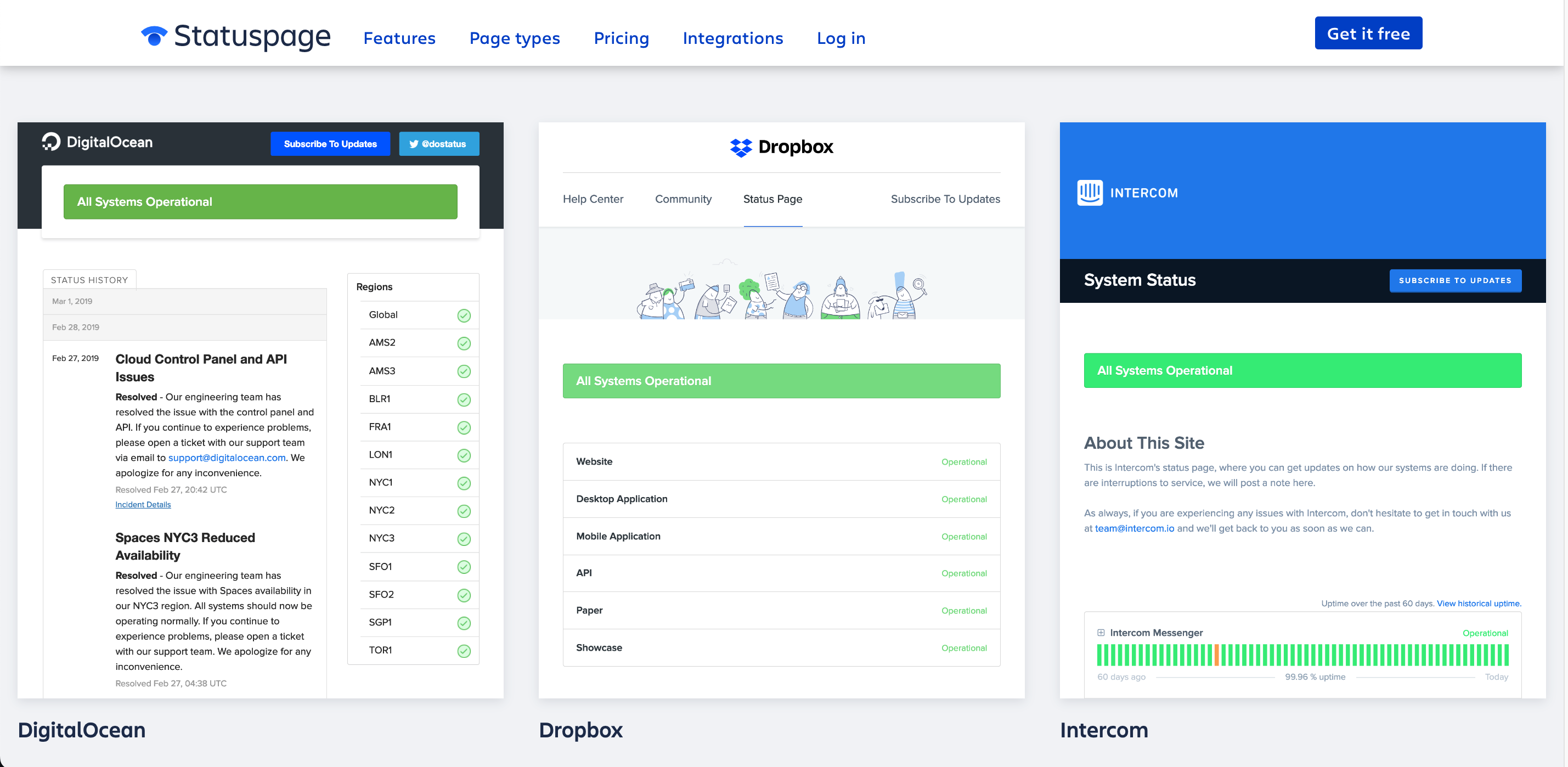
Statuspage is a popular status page provider used by thousands of teams to communicate the status of their services. Atlassian acquired Statuspage, a Y-Combinator-backed service, in 2016 and invested significantly in expanding status page features to stand out among Statuspage alternatives.
Overall, Statuspage is a well-established status page software, but it comes with a higher price than other Statuspage.io alternatives. That’s why it’s not uncommon for people to look for status page alternatives.
Statuspage Alternative #1 – StatusGator
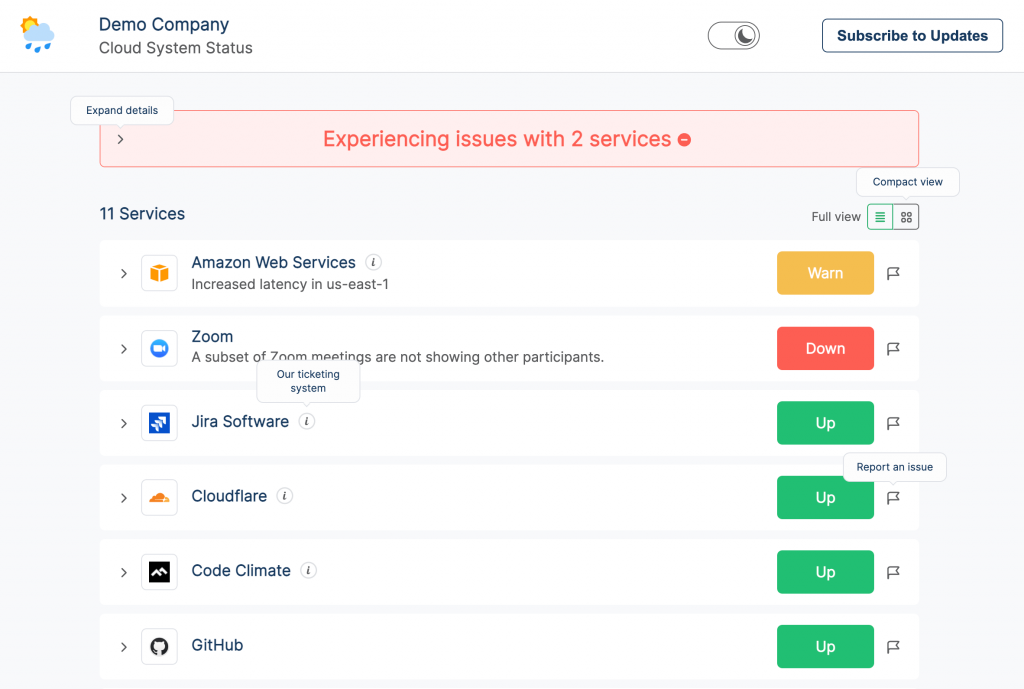
The first thing to note is that StatusGator is not a typical Statuspage.io alternative. On top of the basic status page functionality, StatusGator offers a unique service of status aggregation from 2,700+ services.
This means that StatusGator allows you not only to communicate your internal services’ statuses but also the statuses of all your cloud dependencies such as hosting, payment gateways, critical APIs, and other dependencies. By aggregating and normalizing all the status data together, you can directly monitor your own service and the providers you depend on.
This powerful combination makes it the ideal tool for internal team and IT status pages.
StatusGator vs Statuspage.io
The key difference with StatusGator is that it can aggregate the status of any cloud service (such as AWS, Zoom, Microsoft 365, etc.) or a website into a single status page. It also has a direct monitoring feature to monitor internal tools, your own website, and other services without status pages. It is not something offered by Statuspage.io.
For most companies, StatusGator is significantly cheaper than Statuspage.io.
StatusGator also sells private and public status pages on a single plan.
Benefits of StatusGator
- All status page features you need in one plan
- Private and public status pages in a single plan
- Unlimited status page subscribers
- 3,000 cloud services statuses on your status page
- Website monitoring built-in, no third-party tool is needed.
- Custom domain, logo, and favicon upload
- Branding removal
- White-label status page
- Password protection
- 2FA and SSO
- Generous pricing
- Free plan on a public status page
- Free trial as part of all plans.
Better Uptime as a Statuspage Alternative
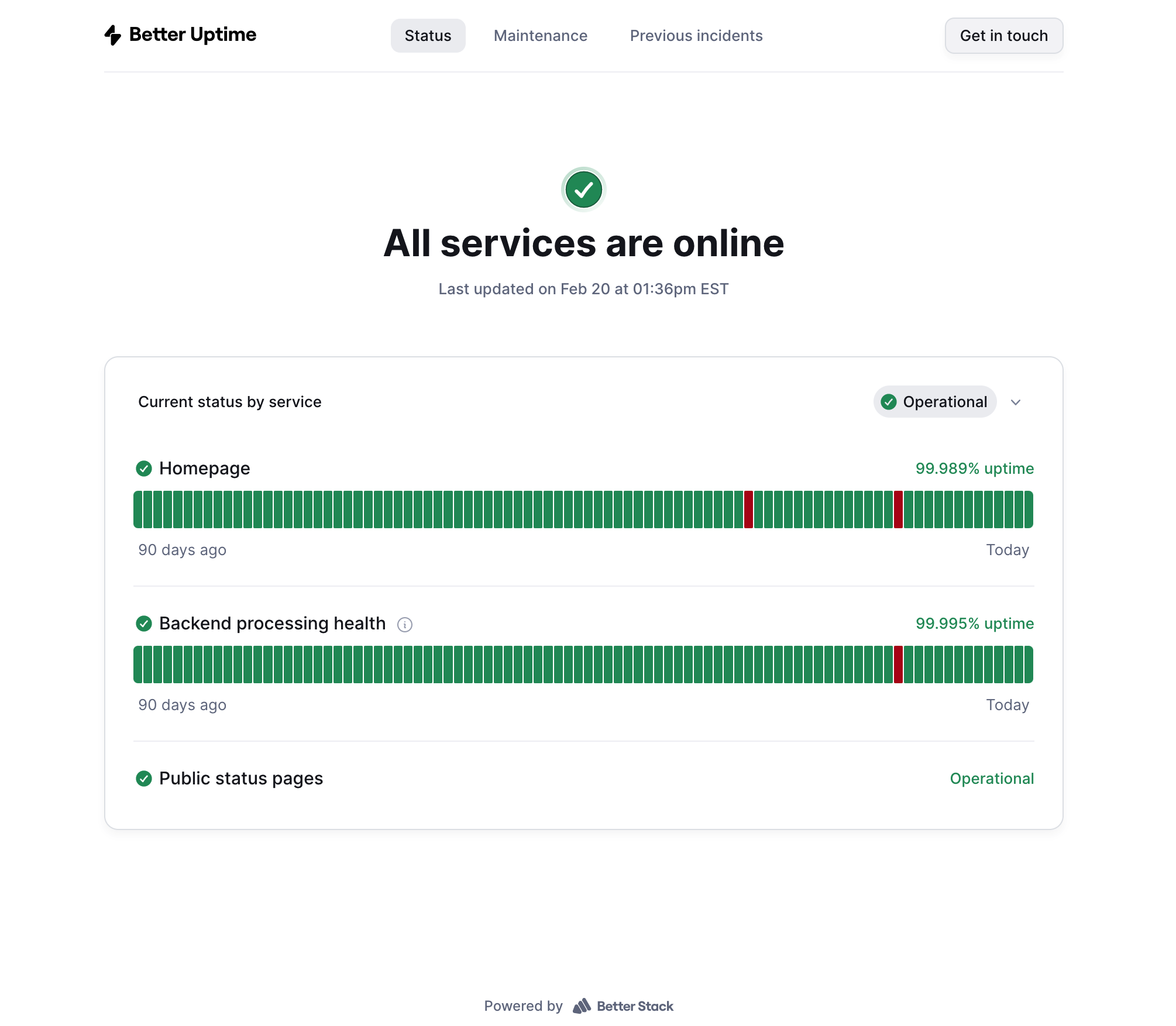
Better Uptime combines incident management, uptime monitoring, and status pages into a single product.
Their incident management system offers easy-to-use, on-call calendar scheduling in-app or integrated with Google Calendar. Similar to PagerDuty, there are advanced team management and access features.
Also, when it comes to alerting, Better Uptime offers unlimited phone calls and SMS alerts on all paid plans. There are also options to integrate with Slack and Microsoft Teams. In addition, you can embed incident screenshots and debugging information directly into alerts.
The main benefit of Better Uptime, however, is that it has built-in synthetic monitoring via:
- HTTP(s)
- Ping
- SSL&TLD expiration
- Cron job
- Port monitoring.
These monitors can be integrated with the on-call alerting system without the need to integrate any third-party monitoring tools like Pingdom or UptimeRobot.
When it comes to integrations, Better Uptime offers a wide range of monitoring and analytical integrations that are ideal for more demanding users. Overall, it’s a strong Statuspage competitor for those who need monitoring software and not only a status page.

Better Uptime vs. Statuspage.io
Better Uptime offers a free status page that is simply basic. It is connected to all existing monitors and can be edited in seconds. Status pages can be fully customized and published on a custom domain.
Paid plans allow users to set up password-protected pages, as well as e-mail and API status subscriptions.
Benefits of Better Uptime
- Free status page for all users on a custom domain
- Uptime monitoring built-in
- Embeddable system status notice
- Integration with StatusGator to additionally give visibility into the statuses of all of your vendors
- Widget for the website.
Better Uptime integrates with StatusGator, and can add up to the services of hosted status page, monitoring, and aggregation that StatusGator provides.
Cachet as an Open Source Alternative to Statuspage
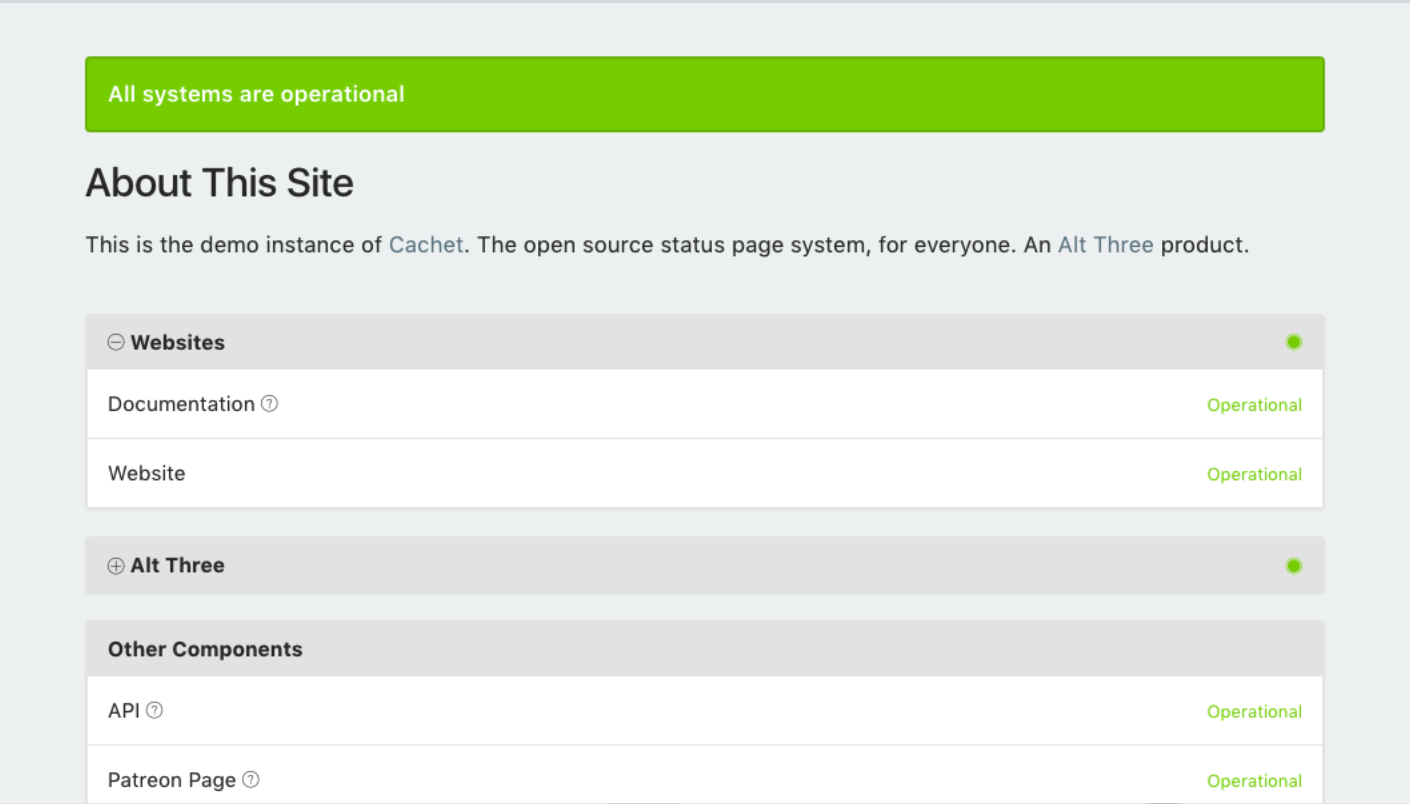
Cachet is an open-source status page system made using Bootstrap 3 – allowing for a responsive design. It’s an impressive Statuspage competitor, as Cachet offers basic uptime monitors displayed on a dashboard.
With their API, you can easily set up any metrics you want on the Cachet dashboard, be it uptime, error rates, or response times.
Cachet has the option to schedule maintenance. It can greatly boost transparency between your services and their users.
A great benefit to anyone looking for extra security is that Cachet also offers two-factor authentication with the Google Authenticator app. However, there are prerequisites to installing Cachet – something to keep in mind.
Cachet vs. Statuspage.io
Overall, Cachet is free (always good) and customizable in many ways, as it is an open-source service.
Cachet’s UI is outstanding with its dashboard. Cachet’s Slack community serves as support and inspiration for setting up. It’s clear, that Cachet is a strong competitor and an impressive alternative to Statuspage.io if you are looking for an open-source solution.
Benefits of Cachet
- Free
- Customizable with built-in tools
- Enables user to display any metric on the dashboard
- 2FA (Two-factor authentication) is compatible with the Google Authenticator App
- Multiple languages are available
- Slack community
- Outstanding with its excellent chart dashboard.
Instatus as a Statuspage Alternative
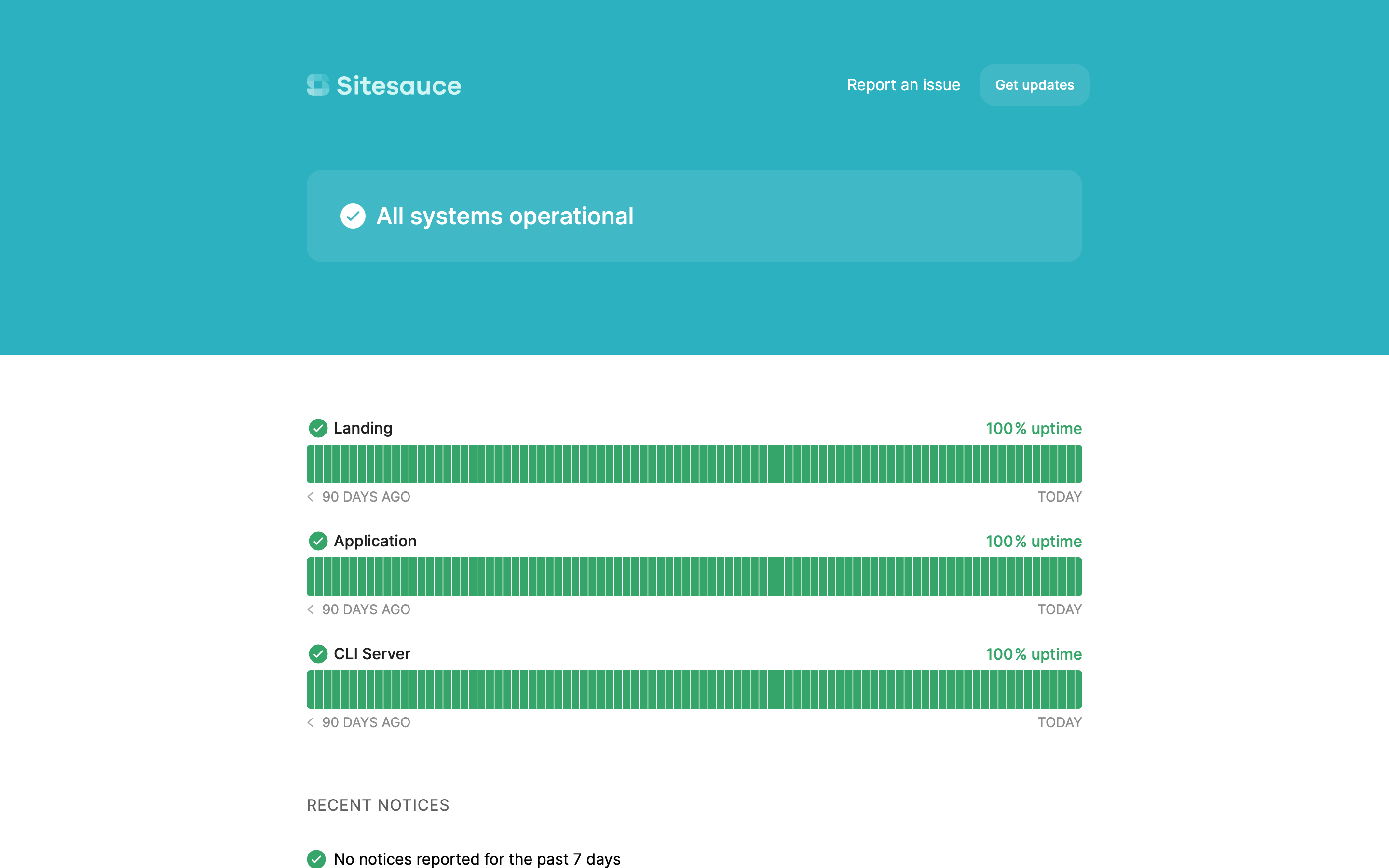
Instatus is a new status page provider but still a strong alternative to Statuspage. Firstly, they offer a free status page with unlimited subscribers and unlimited teams.
However, the catch is that it is not on a custom domain. If a custom domain is not a significant issue for you, then it can be the right provider of a status page for you.
Instatus’ features are something you would expect – email subscriptions, scheduled maintenance, incident templates, API, and integration with incident management tools like PagerDuty.
Instatus vs Statuspage.io
The key aspect of the Instatus paid plan is that it starts at $20 per month and offers the same product but with the option to get it on a custom domain. However, Instatus has separate pricing on private and public pages similar to Statuspage, it depends on your needs. In a nutshell, the difference comes with the rates.
Overall, Instatus is a very well-designed tool that is a similar alternative to Statuspage. It focuses on distinguishing itself, mainly with reasonable pricing for smaller teams and businesses.
Benefits of Instatus
- Allows users to add status widgets on the website
- Price does not depend on the number of subscribers – subscriptions are unlimited
- Clean and simple design
- API and integrations with incident management tools like PaperDuty.
Status.io as a Statuspage Alternative
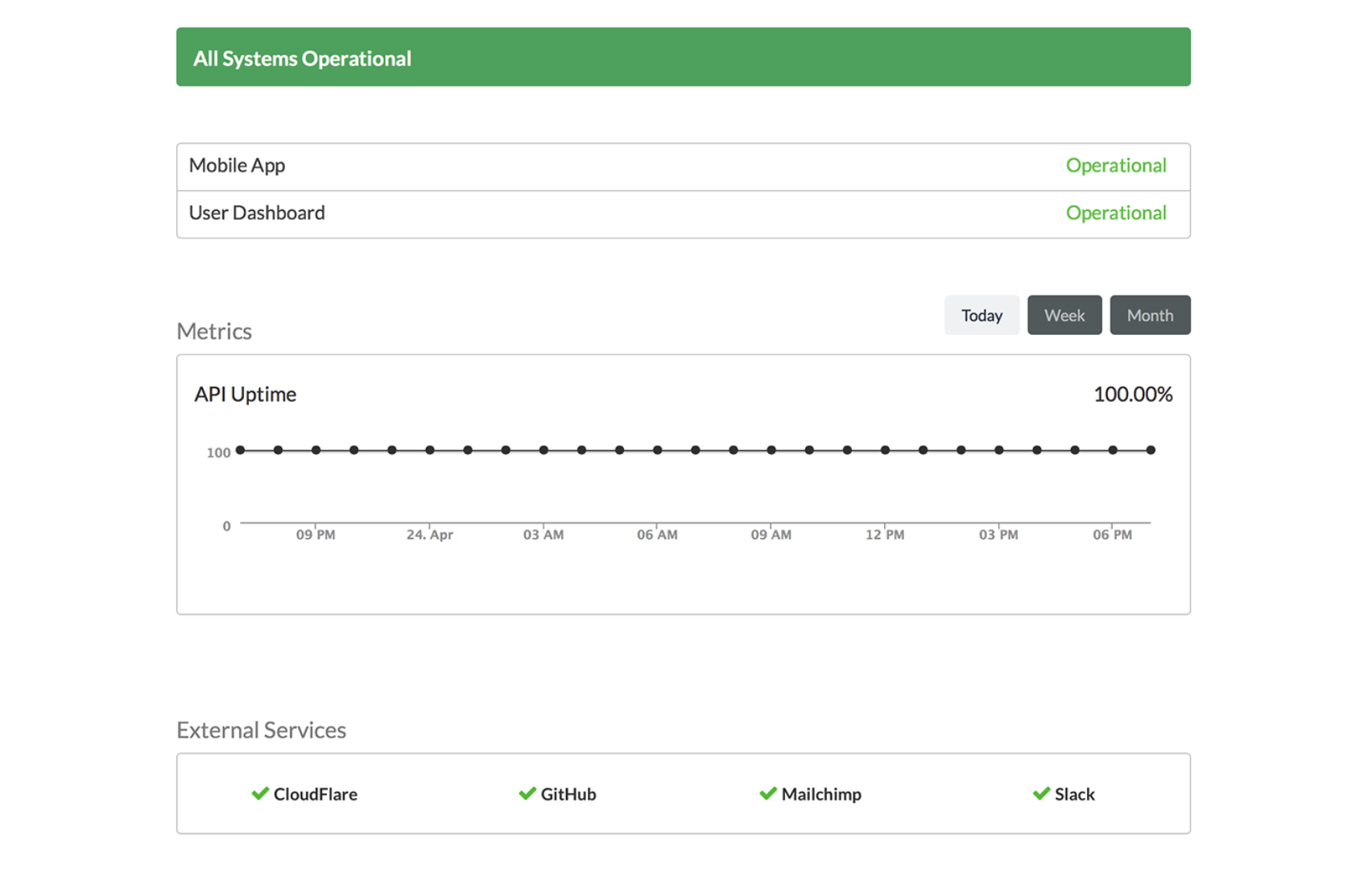
Status.io provides hosted system status pages for your app or web service. The infrastructure of Status.io is powered by multiple systems located in different corners of the world.
Its features include customized incident tracking, subscriber notifications, and much more. Users can add elements of their brands and tweak the code to customize their status pages.
Status.io offers users an extra status page for testing, which can be very useful for some users.
As for the technical overview, Status.io includes complete control for complex distributed systems and multi-tenant infrastructure.
All status pages also include a unique API method, meaning developers can retrieve the current status easily.
Shortly, Status.io can offer:
- Display of performance monitoring metrics
- Subscriber notifications
- Data sharing with multiple tools
- Link monitoring tools for status automation
- Twitter broadcasts.
Status.io vs. Statuspage.io
Status.io is a slightly cheaper alternative to Statuspage when it comes to enterprise plans with 5,000 subscribers.
Status.io includes a private status page and third-party status display in its plan. However, it is not clear how many third parties are available (StatusGator currently offers 2,700+ providers).
Benefits of Status.io
- Automatic notifications on the current status of the appropriate component triggered by updates
- Maintenance scheduling
- Metric display via Custom Metric API or external data source
- Customizable
- SSO and access control based on IP.
UptimeRobot as a Statuspage Alternative
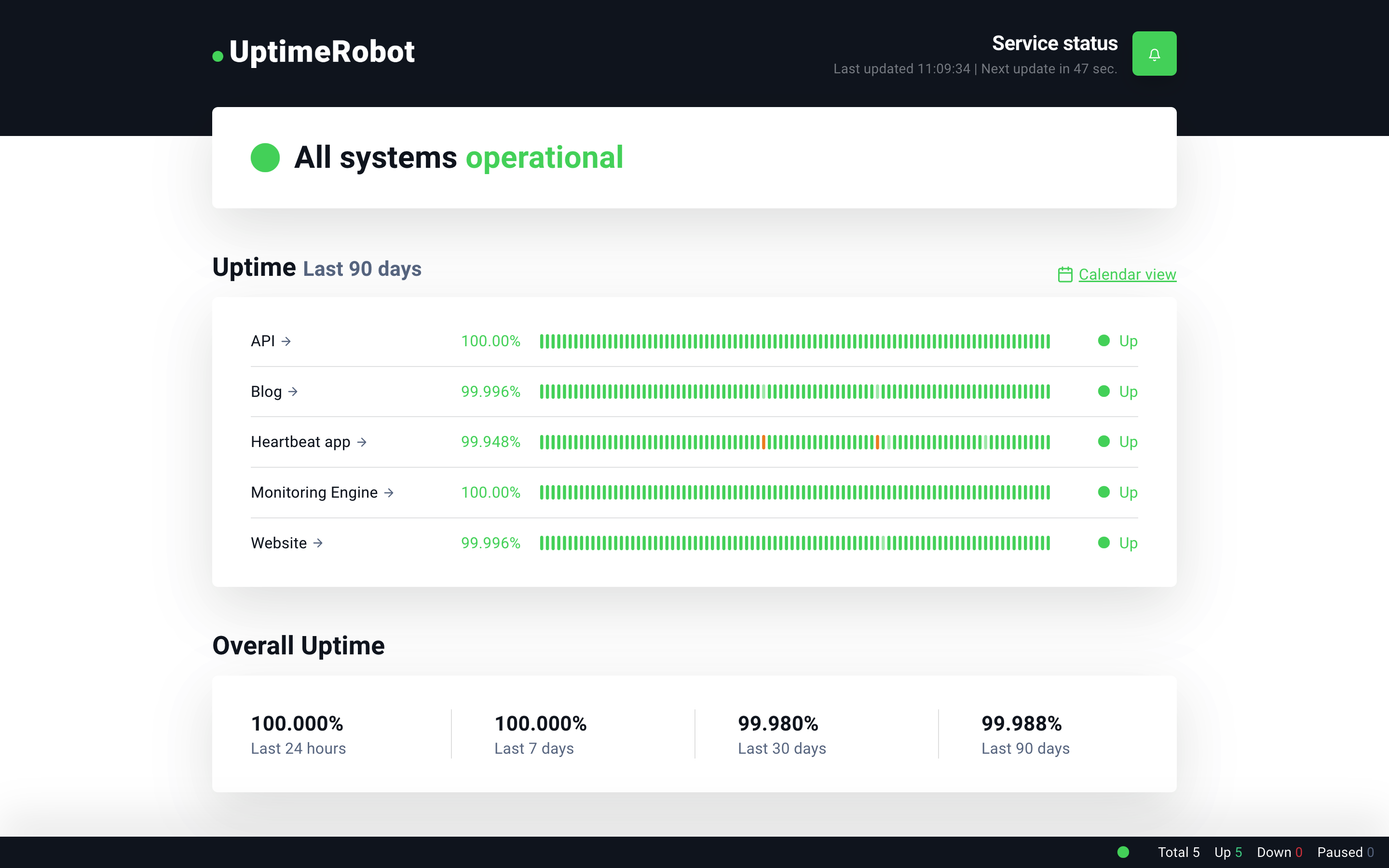
UptimeRobot is an uptime monitoring service that performs monitoring for the following:
- Website
- SSL
- Ping
- Port
- Cron
- Keyword monitoring.
The free plan includes setting up 50 monitors and a single status page. The plan is designed to try the product out mostly, as it limits all the functions of the status page.
White-label status pages become available with the Team plan for $29 per month if paid annually. Unlimited status pages are available with the Enterprise plan for $54 per month, charged annually.
UptimeRobot vs. Statuspage.io
UptimeRobot offers unlimited white-label status pages only with a paid plan. Status pages are secondary in the services provided by UptimeRobot, while uptime monitoring is their primary product.
Benefits of UptimeRobot
The two key benefits of UptimeRobot are:
- Users can set up maintenance windows to inform subscribers about planned maintenance
- 10-day money-back guarantee if their plan does not work for you.
Upptime as a Statuspage Alternative
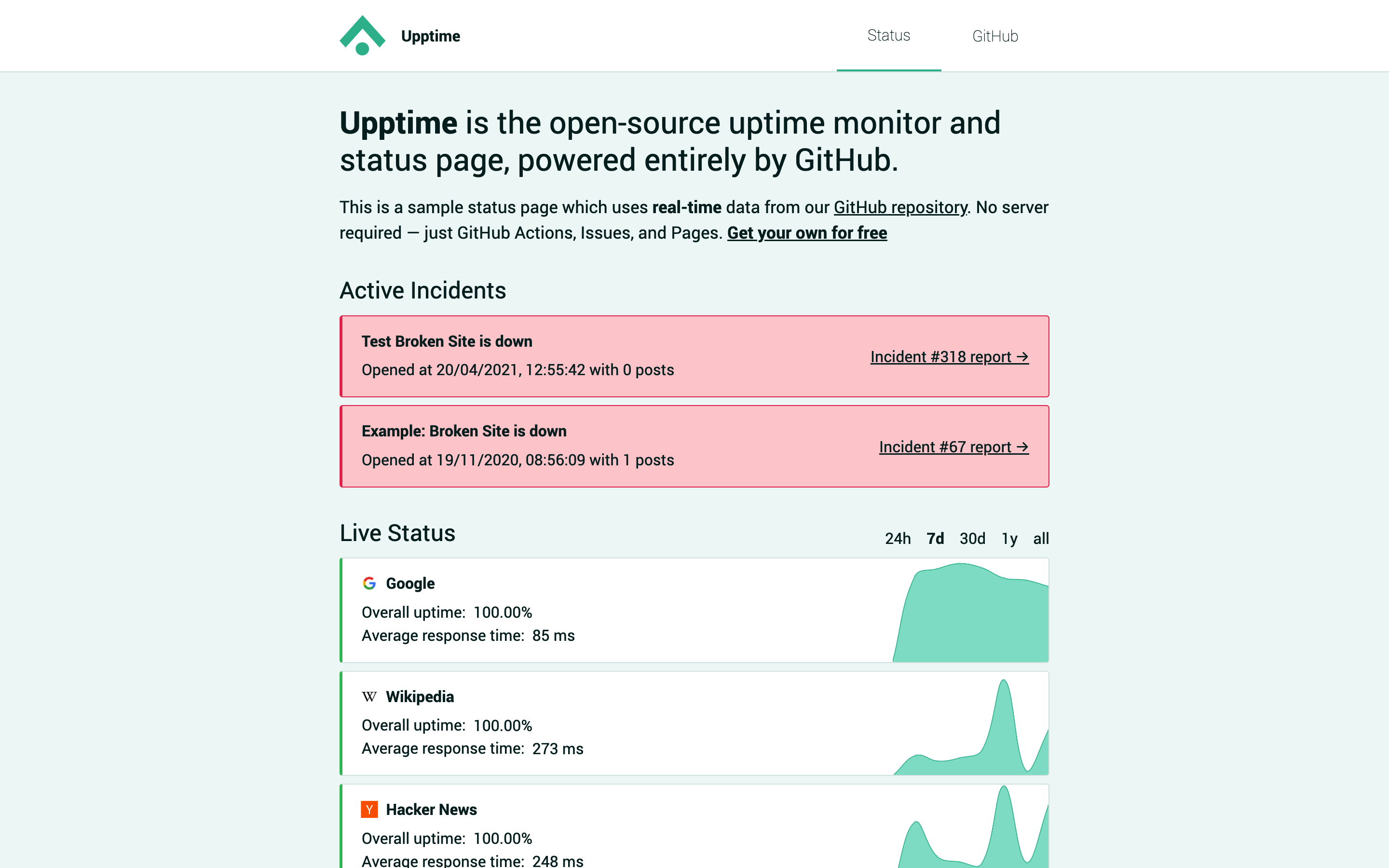
Upptime is an open-source uptime monitor and status page, powered entirely by GitHub. Similar to Cachet, it uses GitHub Actions, Issues, and Pages.
With GitHub Actions, Upptime enables users to schedule workflows to run automatically in pre-set time intervals. The shortest interval that is allowed is 5 minutes. This means that Upptime checks your website automatically every 5 minutes and reflects your website status on the status page.
Another interesting point is that once a day, Upptime generates graphs of the website’s response times. With this, you can easily see and broadcast your long-term statistics.
Lastly, the Upptime website offers customization of your status page. Those include changing logos, copy, graphs, and more.
Upptime vs Statuspage.io
It is an open-source and free Statuspage.io alternative, but, it means that no subscriptions are provided. Yet, t is highly customizable and has good documentation.
If you are seriously considering Upptime, check the report on GitHub’s reliability, since Upptime users depend on it.
Benefits of Upptime
- No server is needed, as the service runs from a GitHub repository (template available)
- Free and open-source software
- Great design (themes available)
- Plenty of functionality
- Efficient status updates (every 5 minutes).

Statuspage Pricing
Statuspage offers a free plan that comes with basic features: 100 subscribers, 2 team members, email and Slack notifications, and access to REST APIs.
The lowest-tier plan for a public status page starts at $29 per month. There is no custom domain with the free plan, but there is on the paid plans.
On higher plans, you get access to team member SSO, custom CSS, HTML, and JS. Also, you get role-based access control and an option for your users to subscribe to specific components of your service. However, these plans have a significant price increase.
Statuspage pricing depends on the number of status page subscribers, team members who have editing access, and the number of metrics displayed on your status page. Also, here is separate pricing for public, private, and audience-specific pages.
How Is Statuspage Different from Other Status Page Software?
There are quite a few tools that provide a status page.
Some are hosted status page services, like Statuspage.io, Instatus, and StatusGator. While others are open-source, meaning you will have to host your status page on your own.
The difference here is that open-source status page providers are free. Yet, hosting a status page on your own infrastructure is not free.
Also, Statuspage.io is focused on providing a single service of communicating the status of your product and services with its users. Whereas other status page tools provide additional services such as status page aggregation or monitoring.
For example, monitoring service pings your servers or websites to learn if they are up or down. The results are reflected on your public or private status page. Some status page providers include monitoring services already in the core product, such as StatusGator or Better Uptime. Some rely on third-party services like Pingdom.
Status page aggregation is another unique feature that allows you to see the statuses of all your cloud vendors, critical API, and other third-party dependencies on your status page, both private and public. StatusGator is the most advanced status page aggregator on the market. It allows you to choose from 2,700+ cloud services (such as AWS, Google Cloud, GitHub, Zoom, etc.) to add to your status page. Some services, like Status.io, mention that you can add the status of external services, but you can only do it via API if the external service allows it.
A Side-by-Side Comparison of Statuspage.io Alternatives
The table below will help you navigate the differences between the alternatives to Statuspage and a side-by-side comparison of Statuspage.io price.
| Criteria | StatusGator | Statuspage | Better Uptime | Cachet | Instatus | Status.io | UptimeRobot | Upptime |
|---|---|---|---|---|---|---|---|---|
| Primary category | communication, monitoring, aggregation | communication | monitoring | communication | communication | communication | monitoring | monitoring |
| Key differences | ||||||||
| Private status page | ✅ On all plans | From $79/month | From $200/month | ❓ | For $50/month | For $349/month | For $348/month | ❓ |
| Components display | ✅ | ✅ | ❓ | ✅ | ✅ | ✅ | ❓ | ❓ |
| Website monitoring | ✅ | ❌ | ✅ | ❌ | ❌ | ❌ | ✅ | ❌ |
| Monitoring - third-party service statuses | 2,800+ | 200 | ❌ | ❌ | 168 | 170 | ❌ | ❌ |
| Trial | ✅ | ❌ | ❌ | ❌ | Only on private pages | ❌ | ❌ | ❌ |
| Cost per month | Starts at $72 | Starts at $29 | Starts at $30 | Free | Starts at $20 | Starts at $79 | Starts at $7 | Free |
| Status page features | ||||||||
| Hosted | ✅ | ✅ | ✅ | self-hosted | ✅ | ✅ | ✅ | ✅ |
| Favicon | ✅ | ✅ | ❓ | ✅ | ✅ | ✅ | ❓ | ✅ |
| CSS | ✅ | On paid plans | ✅ | ✅ | ✅ | ✅ | ❓ | ✅ |
| Branding removal | ✅ | ❓ | ❓ | ❓ | ❓ | On Standard plan and higher | On PRO plan and higher | ❓ |
| Components display | ✅ | ✅ | ❓ | ✅ | ✅ | ✅ | ❓ | ❓ |
| Subscribers to status pages | Unlimited | Limited | Limited. Available on higher plans only | Unavailable | Unlimited | Limited. Quantity depends on the plan | Limited. Available on higher plans only | Unavailable |
| Notifications | Email, SMS, Slack, MS Teams, Discord | Slack email, Webhook | Voice call, SMS, Mobile pushSlack, Microsoft Teams | SMS, Discord Slack, Twitter, Micrisoft teams, email | Twitter, SMS, voice call, Email, Slack, Discord Telegram | Email, SMS, voice call, Slack, Zapier, Twitter | Slack, Telegram, Webhooks |
|
| Password protection | ✅ | On Starter plan and higher | On Business plan and higher | ✅ | On Private PRO plan and higher | Authentication via SSO, SAML Identity Providers, IP Access control | ❓ | ❓ |
| Monitoring | ||||||||
| Ping interval | 5 min | 30 sec | 3 min or 30 sec on Freelancer plan and higher | ❓ | ❓ | ❓ | 5 min or 1 min on PRO plan | 5 min |
| General | ||||||||
| Documentation | Great | Good | Good | Great | OK | OK | OK | Good |
| Support | Contact form, email, chat | Contact form | Email, chat, phone | Email, Help with installation $249 | Chat, email | Chat | GitHub | |
| Account security | 2FA, SSO | 2FA, G Suite and SAML single sign-on | 2FA, GDPR, SSO on Enterprise plan | 2FA | SSO / SAML on Business plan | 2FA with Yubikey,Custom TLS / SSL Certificate, IP filtering, | 2FA | ❓ |
Summary
We reviewed the 7 best alternatives to Statuspage.io so that you can decide which one works best for you.
Each has its own attributes, both similar to Statuspage and offering some extra functionality. All the software mentioned are strong competitors and alternatives to Statuspage.io.
Here’s a list of points to consider before choosing:
- If you need to monitor your cloud dependencies and communicate the status of these dependencies on your status page – choose StatusGator.
- If you need a monitoring tool and incident manager along with a status page — check out Better Uptime.
- For users who are interested in a self-hosted status page – try Cachet. Users point out the ability to set up any metric and robust documentation to cover any questions.
- Status.io could work well for users who have an account with Librato, New Relic, Pingdom, or a custom monitoring tool and are looking to automate communicating status to their users.
- Instatus is a communication tool that has quite a simple pricing system that does not depend on scaling business. If you manually create incidents and do not need to monitor anything, it can work well.
- You could check out UptimeRobot for status pages if you are looking for a solution to monitor websites, ports, SSL, and cron job.
- If you are looking for a monitoring solution that also offers status pages and is open-source, then see if Upptime fits your criteria.

FAQ on Statuspage alternatives
Q: What is the best alternative to Statuspage.io?
A: StatusGator is an alternative to Statuspage.io. It provides more than a status page. StatusGator aggregates all your status data of the cloud services you depend on into a single status page. It’s cheaper than Statuspage.io too, and it combines all public and private status pages into one plan, meaning you don’t need to worry about individual pricing. On top of this, there is also an internal monitoring tool – so you have all bases covered with StatusGator.
Q: Which status page software is better?
A: Due to its unique features, StatusGator is the best status page software you can use. You can create a single status page from all the statuses of your cloud dependencies. The status page can be either public or private, for affordable prices. It’s easy to use and can go a long way toward transparency between you and your customers. It also has internal monitoring tools for your services, third-party dependencies, etc. Currently, StatusGator monitors and normalizes status data from 2,670 cloud services.
Q: What is the difference between open-source and paid status page software?
A: In short, the open-source status page solution is free, and you host and set up your status page on your own. It’s worth mentioning that hosting is never free. On the other hand, paid software is where a status page is effectively made and hosted for you. You can have your hosted status page in a few minutes with StatusGator. Moreover, you can also add the statuses of your cloud dependencies. It makes StatusGater a great alternative to Statuspage.io.
Q: Who are the main competitors of Statuspage.io?
A: The main competition to Statuspage.io is StatusGator as it offers more than a public, private, or password-protected status page. The statuses of cloud services can be added to a user’s status page too. Also, StatusGator is cheaper.
Q: What are the benefits of having a status page?
A: The key benefit of having a status page is that it goes a long way toward transparency between you and your customers. With StatusGator, you can also have a bird’s view into your cloud services. So not only your users are aware of the status of your services, but you also get a view into the reliability of your dependencies.
A variety of status pages offered by Status Gator
- Why K12 IT directors love StatusGator
- How StatusGator is different
- Issue reports and early warning signals: Now in Beta
- Case study: How a large PA public school district enhances IT service monitoring with StatusGator
- 10 Best Uptime Kuma Alternatives: Exploring Hosted and Open-Source Monitoring Tools
